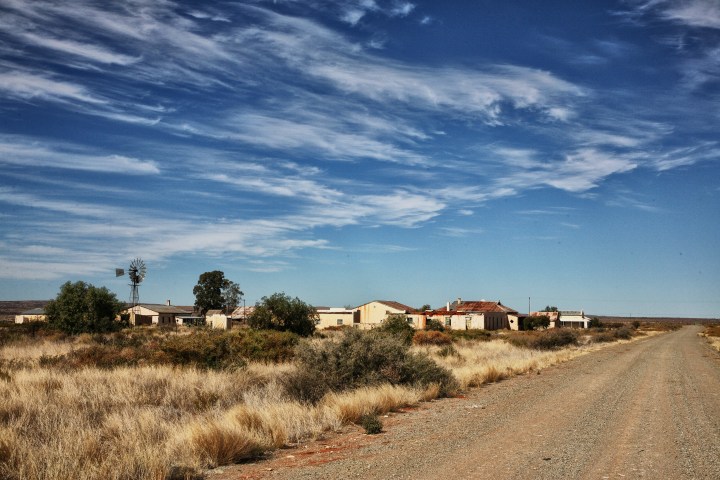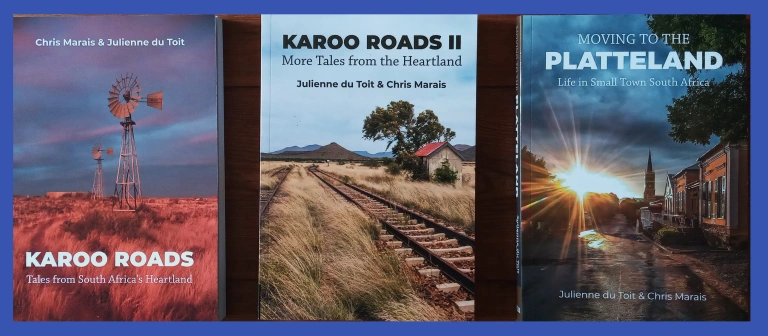Escape
Legends of a grand old railway station in the Karoo – Putsonderwater Ghost Station

In South African mythology, the name Putsonderwater ranks alongside exotics like Shangri-La, Xanadu, Timbuktu, Camelot, the Hanging Gardens of Babylon, Dodge City, Mandalay and the Irrawaddy River. Some exist today. Some exist no more. Some never existed at all.
There are rows of giant grassy lollipops on telephone pole sticks lining the dusty R383 on the road to Putsonderwater Station, between the Northern Cape towns of Kenhardt and Marydale.
Birdwatchers will immediately recognise these strange arrays as the enormous nests of sociable weaver colonies, the largest bird constructions in the world. Despite their shaggy appearance, each one is carefully built up by the ceaseless efforts of hundreds of the tiny, nondescript birds.
As many as 300 sociable weavers will live in a structure weighing a tonne or more, and every day each bird will bring back grass stalks to add to the nest.
After the “giant lollipops”, you come to what is left of Putsonderwater Station and the little village that once flourished alongside it.

The Lollipop Highway of sociable weaver nests leading the traveller to Putsonderwater Station. Image: Chris Marais

The once-popular community church on the outskirts of the ghost village. Image: Chris Marais

Posing at Putsonderwater – Julienne du Toit waits for a train that doesn’t stop here anymore. Image: Chris Marais
In South African mythology, the name Putsonderwater ranks alongside exotics like Shangri-La, Xanadu, Timbuktu, Camelot, the Hanging Gardens of Babylon, Dodge City, Mandalay, and the Irrawaddy River. Some exist today. Some exist no more. Some never existed at all. Many people use the name of Putsonderwater when referring to impossibly far-off destinations, without realising the settlement was once very much alive.
Up until the early 1990s, Putsonderwater was a notable stop on the railway route between Cape Town and Windhoek, capital city of Namibia. A general dealer, hotel, police station, post office, school and interdenominational church all thrived here.
In the late 1980s, Putsonderwater won the coveted Lady Duncan Trophy for best country railway station in South Africa. Former stationmaster Ken Magson remembered the gardens as being particularly beautiful.
“The winters were deliciously cold. The summers were dry and hot. I lived there with my wife and two sons, who went to boarding school in Marydale, about 36km away,” he said. “Visitors used to come to the station and remark on what an oasis it was. You didn’t laugh at Putsonderwater in my day.”

Is this possibly the famous Putsonderwater well?
Image: Chris Marais

Ranch house-style Kalahari stoep houses for cool summer breezes. Image: Chris Marais
According to local legend, the origin of the name “Putsonderwater” harks back to the early 1880s and an old farmer called David Ockhuis. He came to live at this spot and dug a well with his sons, Hans and Gert. They found a good vein of water and were well set. But the problem lay in the streams of trekboers (seasonal graziers) who were moving all over South Africa during that unsettled era.
In such a dry land, a water source would be a great attraction to nomads passing through. Ockhuis, not having a title to the land, was afraid that if everyone found out about the water, he would lose his farm. So every time a trekboer arrived and asked about the well, he would say:
“Ja meneer, ek het ‘n put, maar dit is ‘n put sonder water.” (Yes, sir, I have a well, but it is a well without water.) So the place became Putzonderwater. In later years, the “z” was dropped in favour of the modern spelling. DM/ML

“Karoo Roads”, “Karoo Roads II” and “Moving to the Platteland” by Chris Marais and Julienne du Toit book covers.
For an insider’s view on life in the Karoo, get the Three-Book Special of Karoo Roads I, Karoo Roads II and Moving to the Platteland – Life in Small Town South Africa by Julienne du Toit and Chris Marais for only R720, including courier costs in South Africa. For more details, contact Julie at [email protected]
In case you missed it, also read Richmond, between Johannesburg and Cape Town – a culture town worth the stop
Richmond, between Johannesburg and Cape Town – a culture town worth the stop
Visit Daily Maverick’s home page for more news, analysis and investigations


















When I passed by there in the late 1990’s the place was just as abandoned, and even the rails were rusty on their surfaces. There clearly hadn’t been a train in weeks. In this photo, they are somewhat shiny, so there are still trains.
Of course, Putsonderwater was the title of the play by Bartho Smit.
Set in a small South African village, the characters are representatives of religious, secular and political power, and the playwright’s exploration of their relationship with the young virgin, constitutes a virulent attack on social hypocrisy.
He submitted the play to NTO as possible opening piece for the newly built Johannesburg Civic Theatre, but it was rejected by the management because somebody had noted that the father of the illegitimate child carried by “Maria”, the white teenage girl, was “Asgat”, a young “Coloured” man. In view of this the play was afterwards also denied performance in other parts of South Africa for many years.
Apparently had only received its first fully professional production twenty years after it was written. I saw a student production at Rhodes University in 1969. Although the ESAT says it was done in 1968, it may well have been repeated. I am checking on that. It was the first production of the play in South Africa.
1968: Directed in September at Rhodes University in by Abraham H. de Vries, with Nelia Dryer, Hugh Forsyth, Wilfred Jonckheer, John Badenhorst, Tom Cloete, Noël Roos, Bill Sieberhagen in the cast.
I’d also meant to say it was a lovely article and beautiful photos, Chris. Wouldn’t it be wonderful if we had trains running again and someone started a B&B in Putsonderwater?
One of the student actors who was in that production responded to my query when I said I was sure I had seen it in 1969.
Yes, 68 was the SA premiere but Nelia pulled a muscle on the first night and had to abandon the performance. We successfully revived it in 69
Passed through many years ago and stopped to admire this immaculate piece of railway art. Both waiting rooms – Net vir Blankes, and, Nie-blankes – were eat-off-the-floor clean and each was adorned with a large wall poster announcing a reward for anyone providing information leading to the arrest and conviction of blah, blah, railway property, and so on. Once inside, it was difficult to tell them apart (no – not a pun), except that for the Blankes the placard stated “Reward R1000.00” and for the Nie-blankes “Reward R500.00”.
Which reminds me of a brown railways bench on the Cape Flats platform of Heathfield Station, probably in the very early 60’s, on which the rather grand, serified gilt scrip, by careful erasure, had been altered from “Whites Only – Net Blankes” to “it’s Only Planke”.